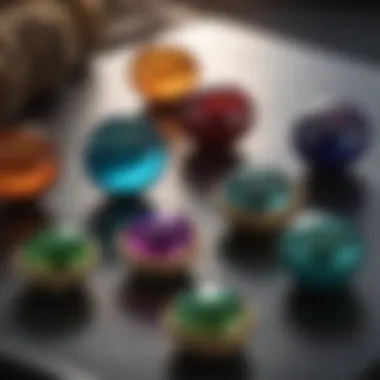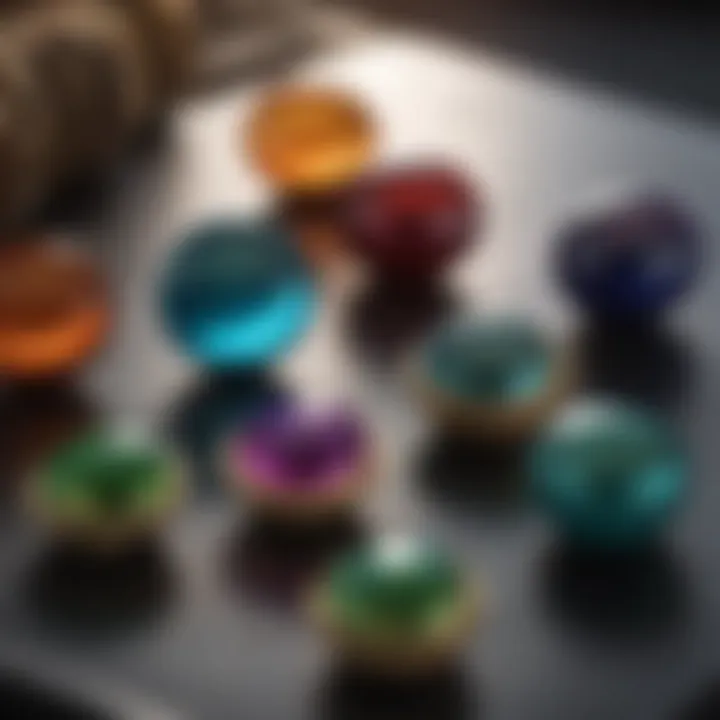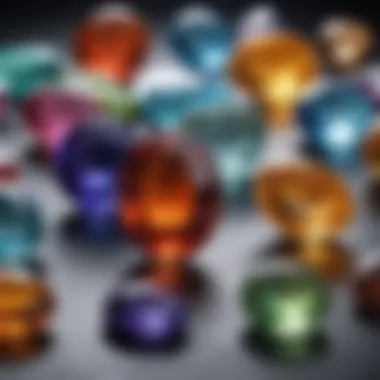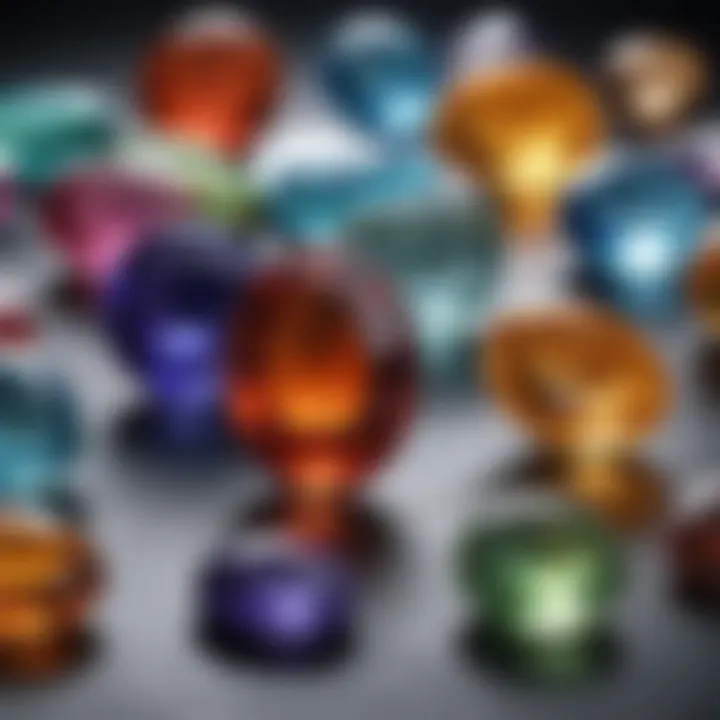Essential Cabochon Tools for Gemstone Cutting Enthusiasts


Intro
Cabochon cutting is a fascinating blend of artistry and precision that requires a deep understanding of tools and techniques. This section serves as an entry point into the world of cabochons, focusing on the fundamental aspects that every enthusiast should master. In the following sections, we will explore the essential cabochon tools in detail, ensuring both novice and expert gem cutters gain valuable insights into the craft.
Gemstone Overview
Definition of Gemstones
Gemstones are naturally occurring minerals, rocks, or organic materials that are cut and polished for use in jewelry and ornamentation. They are valued for their aesthetic appeal, rarity, and durability. Each gemstone is defined by specific characteristics such as color, clarity, cut, and carat weight. Understanding these properties is crucial for any gem cutter, as they influence both the selection of tools and cutting techniques.
Classification of Gemstones
Gemstones are commonly classified into two categories: precious and semi-precious. The term "precious" generally refers to diamonds, rubies, sapphires, and emeralds. These gemstones are known for their rarity and high market value. Semi-precious stones, such as amethyst, garnet, and turquoise, are typically more abundant and vary widely in appearance.
"The classification of gemstones goes beyond mere aesthetics; it reflects the geological processes that formed them and their respective cultural significance."
In the cabochon cutting process, understanding the classification of gemstones helps to determine the best approach for cutting and finishing each type. Different stones may require unique tools and handling techniques due to their varying hardness and fracture patterns.
Historical Significance
Origins of Gemstone Use
The utilization of gemstones dates back thousands of years. Archaeological findings indicate that early humans used gemstones for decoration and as symbols of status. The ancient Egyptians adorned their jewelry with lapis lazuli and turquoise, believing these stones held protective properties. Likewise, various cultures have attributed specific meanings and healing qualities to different stones, which have influenced their use throughout history.
Cultural Insights: Gemstones in Ancient Civilizations
Gemstones played significant roles in the customs and beliefs of numerous ancient civilizations. The Greeks and Romans associated gemstones with the divine, while the Chinese utilized jade for its supposed power to bring luck and prosperity. Throughout time, gemstones have been seen not only as adornments but also as talismans, each carrying its own unique history and significance.
Understanding this historical background enriches the experience of working with gemstones. Enthusiasts gain a deeper appreciation for the stones they cut and the tools they wield, helping to connect the present with a rich past.
Prologue to Cabochon Cutting
Cabochon cutting is a significant area of gemstone artistry that focuses on shaping and polishing stones into smooth, rounded forms. This technique, distinct from faceting, emphasizes the natural beauty and unique characteristics of each stone. In this article, we will delve into the nuances of cabochon cutting, its history, and the various tools that make the process possible. For both novices and experienced enthusiasts, understanding the complexities of cabochon cutting is essential for honing skills and creating stunning pieces.
The cabochon itself, often viewed as a centerpiece in jewelry, draws attention for its brilliant colors and surface. Knowing how to properly cut and finish these stones is fundamental to unleashing their potential. Moreover, exploring this craft unveils the intricacies of morphology and texture that simply cannot be appreciated in rough stones.
Definition of Cabochon
A cabochon is a gemstone that has been shaped and polished, but not faceted. This round or oval form showcases the stone's natural color and features. Unlike faceted gemstones that reflect light through angles and points, cabochons display surface reflections, making color and clarity the main focus. They typically feature a flat base and a curved top, allowing for easy mounting in jewelry. Their wide appeal in necklaces, rings, and brooches highlights their versatility.
Historical Context
The history of cabochon cutting dates back thousands of years, finding its roots in ancient civilizations such as the Egyptians and Romans. During those times, the appeal was in the flow of natural patterns found in stones, like agate and jasper. These civilizations believed in the protective and mystical properties of certain stones, thus leading to the crafting of cabochons that could be used as amulets or decorative pieces.
As techniques evolved, cabochon cutting spread across regions, adapting to local styles and preferences. Today, cabochons are not only valued for their beauty but also for their cultural significance, often becoming statements of individual identity or craftsmanship in jewelry. Exciting advancements in tools and technology have made it possible for more enthusiasts to engage in this craft, ensuring that the tradition of cabochon cutting continues to flourish.
The Importance of Tools in Cabochon Cutting
The craft of cabochon cutting is an intricate process that demands both skills and the right equipment. Tools play a pivotal role in delivering quality, precision, and ensuring that the finished product meets the expected standards. Various tools affect every stage of the cabochon making process, from the initial shaping of gemstones to the final polishing. Understanding their importance helps enthusiasts appreciate how each tool contributes to the craft.
Precision and Quality
Precision is a critical factor in cabochon cutting. Each gemstone has unique characteristics, and using the correct tools enhances the accuracy of cuts. It directly influences how light interacts with the stone, affecting its final appearance. High-quality cabochons exhibit clarity, color intensity, and brilliance. The use of well-designed tools facilitates this level of precision.
For example, diamond wheels are central to cutting and shaping because they maintain sharpness for extended durations. This feature ensures that the cuts are smooth, minimizing the possibilities of chipping or cracking. Achieving a rounded or domed surface is more straightforward when precise tools are utilized. Many cabochon cutters invest in adjustable machines or templates that allow them to control angles and depth of cuts.
Standardization in Craft
In any skilled trade, standardization is fundamental. Tools in cabochon cutting allow for consistent results, which is essential for commercial applications or aspiring professionals. Using uniform tools means that different craftsmen can produce cabochons with similar characteristics, thus establishing a baseline for quality.
Standardized tools also benefit those who teach the craft. Students can learn techniques and skills that are replicable when using the same equipment. This creates a mutual understanding among gem enthusiasts regarding expected outcomes. The tools also allow for easier collaboration in workshops or group settings, fostering a community where experiences can be shared and advanced.
"The right tools not only enhance the quality of craft but also create a framework for learning and standardization, making the craft accessible to new and experienced gem enthusiasts alike."


The importance of tools in cabochon cutting cannot be overstated. Craftsmanship hinges on quality and precision, supported by the correct equipment. As tools advance with technology, the potential for better outcomes increases, encouraging innovation in the craft.
Types of Cabochon Tools
Cabochon cutting is a meticulous craft that requires the right tools. Having appropriate tools significantly affects the quality and precision of the cuts. Each tool serves a unique purpose. Thus, understanding the types of cabochon tools is critical for both beginners and experienced gem cutters. Here, we will explore four primary categories: diamond wheels, carving and shaping tools, polishing tools, and cutting machines.
Diamond Wheels
Diamond wheels are essential in the cabochon cutting process. These tools are distinguished by their hard surface, embedded with diamond particles. They can grind and shape various gemstones effectively. The primary purpose of diamond wheels is to refine the edges and surfaces of stones, allowing for intricate designs. Due to their durability, they are suitable for both soft and hard materials. Adjusting the grit size can assist in achieving the desired finish.
- Benefits of Diamond Wheels:
- They provide precision in shaping.
- They can handle different stone hardness levels.
- The longevity of diamond-infused tools reduces costs over time.
Carving and Shaping Tools
Carving and shaping tools are crucial for adding artistic details to cabochons. These tools come in various forms, including chisels, files, and hand saws. Each tool allows the cutter to manipulate the stone into distinct shapes and patterns. Users can create everything from simple forms to intricate designs.
- Considerations for Use:
- The type of stone influences the choice of carving tool.
- Different shapes of tools provide various design capabilities.
Polishing Tools
Polishing tools are vital for enhancing the final appearance of cabochons. The polishing process is where the stone gains its shine and smoothness. This stage typically employs polishing pads and compounds. The use of fine abrasives helps eliminate any scratches created during cutting and shaping.
- Key Points to Remember:
- The quality of polishing directly correlates with the aesthetics of the finished product.
- Different stones may require different polishing techniques.
Cutting Machines
Cutting machines automate part of the cabochon creation process. These are often equipped with advanced technology that improves precision and efficiency. Unlike manual tools, cutting machines can achieve consistent results. They are perfect for those aiming to produce multiple pieces in a shorter time.
- Factors to Consider When Choosing a Cutting Machine:
- Frequency of use affects what machine is suitable.
- Cost ranges vary based on advanced features.
The exploration of cabochon tools is essential for anyone serious about the craft. Selecting the right tools allows for better outcomes, whether crafting for personal enjoyment or professional purposes.
Essential Hand Tools for Cabochon Cutting
In cabochon cutting, the tools you choose can greatly influence the quality of the final product. Hand tools play a significant role in this process, allowing gem cutters to execute precise adjustments and finish their work to a high standard. Unlike power tools, hand tools offer greater control and finesse. This control is essential for achieving the desired shapes and finishes that define a quality cabochon.
Cabochon Templates
Cabochon templates serve as essential guides when shaping gemstones. These templates come in various shapes and sizes that correspond to popular cabochon designs. By using a template, the cutter can trace or mark the outline on the stone, helping to maintain symmetry and consistency. This is particularly important when cutting multiple stones that require a uniform appearance. Furthermore, templates can aid in visualizing the final shape before any cutting occurs. Hence, the selection of the correct template can significantly streamline the cutting process.
Bevelling Tools
Bevelling tools are critical for creating the right edge on a cabochon. They allow for the smooth transition from the flat surface of the stone to its rounded edges. A well-executed bevel enhances the brilliance of the cabochon by allowing light to enter and reflect correctly within the stone. These tools often come in different sizes and shapes, which enables the cutter to fine-tune the angle and depth of the bevel. The use of bevelling tools is crucial for minimizing chipping and ensuring a polished finish.
Sandpaper and Abrasives
Sandpaper and abrasives are ubiquitous in cabochon cutting, assisting in both shaping and polishing. They come in various grits, from coarse to fine. Coarse grits are used for initial shaping, promoting substantial material removal. As the cutting process continues, finer grits help refine the surface, removing scratches and imperfections. Finally, ultra-fine abrasives bring out the polish, ensuring that the cabochon has a mirror-like finish. This careful selection of sandpaper is necessary to complement the specific characteristics of the gemstone being cut.
"The use of appropriate hand tools is a hallmark of precision in cabochon cutting, enhancing both artistry and craftsmanship in gemstone creation."
Power Tools in Cabochon Production
Power tools play a critical role in cabochon production. They enhance both efficiency and precision, making the cutting and shaping of gemstones more manageable. Amateurs and seasoned stone cutters alike can greatly benefit from these tools. Their usage can significantly reduce the labor intensity of cabochon crafting, while ensuring repeatable results.
Lapidary Saws
Lapidary saws are essential for many gem cutters. They enable precise slicing of rough stones into smaller, workable pieces. There are various types of lapidary saws, including diamond saws, which are preferred for their ability to cut hard materials.


Using a lapidary saw comes with several advantages:
- Accuracy: Cuts made are both precise and clean, minimizing waste.
- Variety: Can be used on different types of stones, from agates to harder rubies.
- Speed: Allows for larger pieces to be processed in shorter time.
Safety is paramount when using a lapidary saw. Operators must wear appropriate protective eyewear and ensure their work area is adequately ventilated. The use of water is essential to prevent overheating and to cool the blade during operation. Proper maintenance of the saw is also crucial for maximizing its lifespan and effectiveness.
Cabochon Machines
Cabochon machines offer another layer of convenience in gemstone crafting. These machines allow users to perform multiple functions, including shaping, grinding, and polishing stones. Such versatility makes them invaluable in a workshop setting.
Some features to consider when choosing a cabochon machine include:
- Motor Power: A strong motor will provide better performance and allow for prolonged use.
- Versatility: Machines should accommodate various attachments, enabling users to cut, grind, and polish efficiently.
- Ease of Use: Beginners should look for machines that are user-friendly while offering the necessary controls for skilled work.
"Investing in the right cabochon machine can transform your crafting experience, allowing for artistic expression and consistent quality."
Using cabochon machines properly requires practice and understanding of the specific functions. Regular cleaning and adherence to the manufacturer's maintenance schedule are vital to ensure optimal functioning.
Choosing the Right Tools for Specific Gemstones
Selecting the appropriate tools for cutting cabochons is a fundamental part of achieving quality results. Different gemstones have unique properties. Understanding these characteristics helps artisans choose tools that can handle specific requirements. This ensures efficiency and reduces damage to the stones during cutting and polishing.
Considerations for Hardness
The hardness of the gemstone is a primary factor in tool selection. The Mohs hardness scale rates minerals based on their ability to scratch one another. Harder stones, such as diamonds and sapphires (rated at 8 to 10 on the scale), require specialized tools. Tools fitted with diamond blades or wheels are essential for these materials. They can withstand the toughness of harder stones.
Conversely, softer stones like calcite or opal (rated at 2 to 4) can be shaped using less rigorous methods. Simpler abrasives and less powerful tools may suffice. Choosing harder tools for softer materials can cause scratches and degrade the stone's surface.
Characteristics of Soft Stones
Working with soft stones impacts tool selection in other significant ways. Soft gemstones can be easily shaped. However, they also require care to avoid excessive heat that could fracture the material. For these, hand tools such as flexible polishing pads can offer the desired smoothness without causing damage.
Additionally, while polishing soft stones, it's crucial to use finer grits to avoid gouging. Soft stones also benefit from materials that cool them during work, preventing overheating. This characteristic further dictates the choice of tools and techniques for successful cabochon cutting.
In summary, understanding both the hardness and the characteristics of specific gemstones informs decisions on tool selection. The right tools enhance the efficiency and quality of the cabochon cutting process, leading to satisfactory results.
"Choosing the correct tools for gemstone working is as essential as the expertise of the person using them. Each gemstone carries its own story, which can be told through careful cutting and polishing."
By focusing on these elements, gem enthusiasts can hone their skills and appreciate the fine details that each stone possesses.
Care and Maintenance of Cabochon Tools
The longevity and effectiveness of cabochon tools depend significantly on proper care and maintenance. These tools are designed to work with delicate and often expensive materials, making their upkeep critical for ensuring both performance and safety. Regular maintenance not only prolongs the lifespan of the tools but also enhances precision in cabochon cutting, which is essential for achieving the desired final product.
Keeping tools in optimal condition minimizes the risk of mishaps during the gem cutting process. This involves not just cleaning, but also careful storage practices, which are crucial for preventing damage from environmental factors or misuse. Engaging in good maintenance habits reflects a professional approach to the craft, which is pivotal for artisans aiming to create high-quality cabochons.
Cleaning Techniques
Effective cleaning techniques are fundamental for maintaining cabochon tools. Generally, dust and gemstone residues accumulate on tools, which can hinder performance over time. A few recommended cleaning methods include:
- Soft Brushes: Use a soft-bristled brush to remove fine dust and debris from tool surfaces. This helps keep them clear of any particles that might scratch precious stones.
- Soapy Water: For more stubborn residues, a solution of mild soap and warm water can work effectively. Dip the tools in this mixture and gently scrub them with a cloth to avoid scratching.
- Compressed Air: Compressed air is useful for blowing off dust and particles from hard-to-reach areas. It is particularly helpful for tools with intricate designs.
- Alcohol Wipes: For quick clean-ups, alcohol wipes can disinfect tools and remove oils or finger marks. They dry quickly and are easy to use.
Implementing a routine cleaning schedule ensures that tools remain in great working condition. After each use, a simple cleaning step can be a good habit to develop.
Storage Recommendations
Proper storage of cabochon tools plays a vital role in their maintenance. Tools should be stored in a manner that protects them from damage. Here are some effective storage practices:
- Toolbox: Utilize a sturdy toolbox with compartments for larger tools and smaller ones. This prevents tools from clanking together, which could cause scratches or dents.
- Protection: Use pouches or cases made from soft material for tools that are particularly delicate. This provides an added layer of protection.
- Organizing: Clearly label compartments for easy access. An organized space makes it easier to find the right tools, thus reducing the need for hastily searching that could result in damaging them.
- Humidity Control: Store tools in a low-humidity environment to prevent rusting. Keeping tools dry is crucial for metal components.
Maintaining the care and storage of cabochon tools crucially influences not just their lifespan but also the quality of the finished cabochons.
In summary, a strong emphasis on cleaning and proper storage for cabochon tools can elevate an enthusiast's mastery of the craft. Regular attention to these practices will lead to better performance and more satisfaction in the art of cabochon cutting.


Safety Practices When Using Cabochon Tools
In the meticulous craft of cabochon cutting, safety practices are essential for ensuring both the well-being of the artisan and the quality of the finished piece. The nature of the tools involved in this art requires a careful approach. Each tool, from diamond wheels to lapidary saws, presents its own set of risks that can lead to serious injuries if not handled properly. Prioritizing safety is not just a personal choice but a necessity that ensures a sustainable enjoyment of this rewarding hobby or profession.
Personal Protective Equipment
Using personal protective equipment, or PPE, is a fundamental safety measure in cabochon cutting. PPE includes a range of items designed to minimize potential hazards while working with gemstone tools. Recommended equipment includes:
- Safety glasses: Protects against flying debris or dust created during cutting and polishing.
- Dust masks or respirators: Helps in filtering out harmful particles that may be inhaled, especially during processes like sanding and grinding.
- Gloves: Provides protection against cuts from sharp tools as well as from abrasive materials.
- Ear protection: Necessary when using loud power tools to prevent hearing loss over time.
Using these items forms the first line of defense in protecting oneself against the physical dangers of cabochon cutting. A thoughtful approach to gear selection helps an enthusiast focus on their craft without compromising their health.
Workspace Safety Considerations
The workspace where cabochon tools are utilized must also be designed for safety. An organized and well-lit area promotes efficiency and prevents accidents. Here are key considerations for creating a safe workspace:
- Proper lighting: Good illumination reduces the chances of mistakes and accidents.
- Stable work surfaces: Ensure the workbench is sturdy, which prevents tools from tipping or slipping during use.
- Clutter-free environment: Keep the workspace organized to minimize distractions and hazards.
- Adequate ventilation: When using powders or materials that generate dust, proper airflow helps keep the air clean and reduces respiratory risks.
Establishing a safe work environment is as crucial as the tools themselves. It nurtures a productive atmosphere that focuses on creativity and craftsmanship while safeguarding the well-being of the artisan.
Innovations in Cabochon Tool Technology
Innovations in cabochon tool technology play a significant role in enhancing the craft of gemstone cutting. With the ongoing development of tools and techniques, gem cutters can achieve higher precision and more intricate designs. This section will explore key aspects of this evolution, indicating how they benefit both novices and veterans in the field.
Emerging Technologies
The introduction of advanced materials and digital technology is reshaping the landscape of cabochon cutting. One notable advancement is the use of diamond-embedded tools. These provide greater cutting efficiency and longer-lasting performance than traditional tools. Laser cutting technology is also becoming prevalent, allowing for intricate cuts that were previously difficult or impossible with manual methods.
Using computer numerical control (CNC) machines is gaining traction. These machines allow for high-speed, precise cuts based on pre-programmed designs. The accuracy of CNC tools reduces waste material and enhances the overall quality of each cabochon produced.
Additionally, there are tools designed with enhanced safety features, which are essential in a craft where precision is crucial. This ensures a more secure working environment, thereby encouraging new enthusiasts to engage without fear of injury.
Future Trends in Tool Design
Looking ahead, several trends are expected to emerge in the design of cabochon tools. Sustainability is becoming more important to consumers, and tool manufacturers are increasingly focused on eco-friendly materials that do not compromise performance. This shift aligns with the growing awareness of environmental impact across industries.
Smart tools incorporating technology such as sensors and automation are also on the horizon. These innovations will provide immediate feedback on the cutting process, helping gem cutters make real-time adjustments to achieve optimal results.
As the market for custom and personalized cabochons continues to grow, tools that offer flexible design capabilities will likely become more common. By integrating user-friendly interfaces with advanced technology, manufacturers can cater to the diverse needs of gemstone artists, enhancing creativity and efficiency.
"The evolution of tool technology is vital for preserving the art of cabochon cutting while also pushing its boundaries."
Overall, as innovations continue to reshape the tools available to gem cutters, the craft will likely become more accessible and enjoyable for enthusiasts at all skill levels.
Ending: The Art and Craft of Cabochon Cutting
The conclusion is not merely the ending of this article; it symbolizes the culmination of understanding the tools and techniques used in the intricate process of cabochon cutting. As we have explored, selecting the right tools is essential for achieving precision and quality in crafting gemstone cabochons. Each tool contributes uniquely to the process, whether it is the diamond wheels that carve out the shape or the polishing tools that bring out the stone's luster. The art of cabochon cutting is deeply rooted in the synergy between the artisan's skill and the functionality of the tools.
One must consider the importance of maintaining a well-rounded toolkit, particularly tailored to the specific types of gemstones one wishes to work with. A knowledgeable selection can enhance both efficiency and artistic expression. This guide has highlighted various tools, such as lapidary saws and sanding equipment, that are integral to the craft. Thus, thoughtful tool selection becomes a key aspect of mastering the art of cabochon cutting.
"The right tools transform raw gemstones into exquisite cabochons, revealing the hidden beauty within."
In comprehending these elements, one gains not only skills but also a deeper appreciation for the craftsmanship involved in this exciting hobby or profession.
Final Thoughts on Tool Selection
The selection of tools in cabochon cutting is a process marked by both practicality and personal preference. Each artisan must assess their own skill level, budget, and the types of gemstones they will be working with. Some tools may be useful for beginners, while others may suit the needs of more advanced cutters. Investing in high-quality tools typically yields better results. It is advisable to prioritize essential items before expanding one's toolkit for more specialized tasks.
Here are some key factors to consider when selecting your tools:
- Quality: Invest in reputable brands known for durability.
- Compatibility: Ensure tools work well with the types of stones you intend to use.
- Comfort: Ergonomic tools can make long cutting sessions more enjoyable.
By carefully considering your choices, you can enhance your efficiency and the quality of your work.
Encouragement for Continuous Learning
Cabochon cutting is not just a technique; it is a continuous journey of learning and improvement. The world of gemstones is vast, with new stones, techniques, and tools emerging regularly. As such, it is vital to remain informed and open to learning opportunities. Engaging with other gemstone enthusiasts can offer fresh insights, innovative methods, and inspiration.
There are numerous resources available that can facilitate this growth, including workshops, online forums, and instructional videos. Being part of communities, such as those found on platforms like Reddit and Facebook, can foster valuable discussions and exchanges.
Continual practice is essential. As your experience grows, experiment with various tools and methods to see how they affect your outcome. Documenting your processes can lead to personal growth and improvement over time. Remember, mastery does not come from a single experience, but rather from a series of dedicated efforts and learnings.



